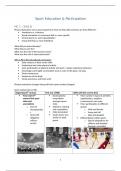Class notes
Slides & notes Sports Education and Participation (PAMIN07..1)
- Course
- Institution
All lecture slides given in the course Sports Education and Participation, part of the minor Sport Science. Also includes personal notes, further explanations of the theory, and information about informative articles to the theory.
[Show more]



